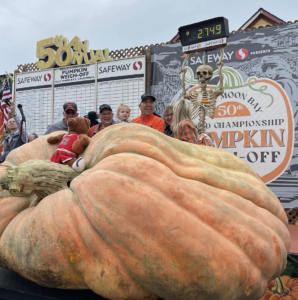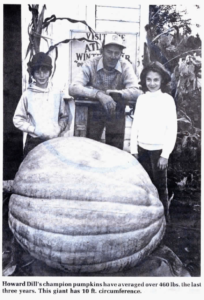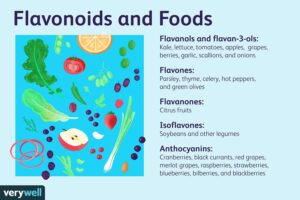The first sip of a warm pumpkin spice latte heralds the arrival of the foliage season. The vibrant orange of pumpkins gracefully infuses the daily life of individuals, harmonizing the bountiful harvest that defines autumn. With its shell-like exterior and tender core, pumpkins became the quintessential autumnal emblem, inviting endeavors such as picking, sculpting, painting, and culinary exploration. As each leaf clings to its branch until the very end, these gourds stand a sentry, safeguarding the essence of the season. Yet, for a select few, the anticipation of fall is an enduring pursuit, as they diligently prepare and gear up for its arrival.

In the realm of autumn enthusiasts, there exists a group of remarkable individuals – pumpkin giants who delicately grow giant pumpkins. These growers undertake the art and science of cultivating colossal gourds, pushing the boundaries of horticultural expertise. They nurture their orange giants as if they were precious works of art. Every drop of water, every pound of soil, every inch of vine… The remarkable fruit of their labor tips the scales at hundreds, often thousands of pounds, defying the norms of gourd growth. On October 9th, 2023, the world of giant pumpkin cultivation witnessed a historic moment when educator and champion pumpkin grower Travis Gienger from Minnesota achieved the latest world record. His mighty orange pumpkin tipped the scale at an astonishing 2749 pounds (1247 kilograms), surpassing the second-largest pumpkin in the world by merely 46 pounds, representing a 1.7% increase in weight. According to Gienger, the massive pumpkin he affectionately named “Michael Jordan” took nearly three decades of blood, sweat, and tears, all in pursuit of exploring the boundless potential of nature’s grandeur.
“Michael Jordan”, the colossal pumpkin marvel, certainly exceeded all expectations upon naming. Unlike the real Michael Jordan, whose extraordinary height of 6’6” (198.1cm) was not apparent at birth, the pumpkin Michael Jordan was set on a journey to greatness as a giant upon seeding, especially because this pumpkin is an Atlantic Giant.
The Atlantic Giant pumpkin, rooted in the Cucurbita maxima squash species, is renowned for its prodigious size. Originating from the meticulous work of Canadian breeder Howard Dill in the 1970s, spanning several decades of selective breeding, the Atlantic Giant has emerged within a lineage spanning over 20 generations of competitive pumpkins. Unlike their culinary counterparts – the more common culinary cousins, the everyday pumpkins – these enormous pumpkins face rigorous evaluation through weight-based competitions. Sporting a robust exterior so impervious that even a chainsaw is required to penetrate them, these remarkable giants boast inner walls that can attain a thickness of almost 11.2 inches (30 centimeters), ascending the pumpkin to the top of the heavy-weight championship.

In a manner reminiscent of Gregor Mendel’s pioneering work with pea plant breeding, Dill undertook the deliberate isolation of male and female flowers within the ancestral lineage of the Atlantic Giant. This meticulous approach allowed him to perform an artificial pollination ritual with the aim of uniting the most desirable characteristics of two parent plants: a vibrant orange hue and the remarkable capacity to break Dill’s wagon. Over the span of 33 years, the Atlantic Giant has achieved an astonishing evolution in terms of size and weight, progressing from just 450 pounds to a remarkable 1600 pounds, and ultimately the extraordinary 2000 pounds. As noted by plant physiologist Jessica Savage, during the peak of their growth season, these prodigious pumpkins have been observed to gain nearly 50 pounds per day.
So, what secrets lie behind the colossal stature of the Atlantic Giant pumpkin? The sheer size of a fruit hinges on the number and dimensions of its fruit cells, shaped by the interplay of cell proliferation and expansion during its growth process. In this context, George Hamilton, an extension field specialist in fruits and vegetables at the University of New Hampshire, underscores the paramount significance of genetics in determining a pumpkin’s potential size. He emphasizes this point emphatically, stating, “Number one is genetics, number two is genetics, number three is genetics.”
In the realm of scientific inquiry, the specific metabolisms of the Atlantic Giant pumpkin have been meticulously scrutinized, distinguishing it from its more common pumpkin relatives. Research has unveiled a higher accumulation of flavonoids and coumarins in these giant pumpkins. While the referenced study did not delve into the potential impact of flavonoids and coumarins on fruit size, building upon this base and considering other existing knowledge of these substances, we can make more informed inferences regarding their potentially significant role in shaping fruit size.
Flavonoids, a category of polyphenolic metabolites found in plants, are familiar to many for their presence in everyday consumables like tea and wine. These compounds are not only used by corporations to deliver direct antioxidant and anti-aging benefits but also play multifaceted roles. In humans, flavonoids have shown the potential to suppress the expression of pro-inflammatory mediators, enhance insulin secretion, and even offer neuroprotection. In plants, they serve as agents for attracting pollinating insects, battling environmental stresses such as microbial infections, and orchestrating cell growth processes.

Fruit size is determined by the number and size of fruit cells, consequence of cell proliferation and expansion throughout growth. During the budding stage of a fruit, cells initiate the process of division and multiplication. Over time, these cells undergo expansion, often increasing in size by up to a thousand-fold their original dimensions. The presence of flavonoids has been shown to promote the cellular division and growth, either through induction of resistance against abiotic stresses or protection against ultraviolet radiation. Therefore, the elevated accumulation of flavonoids support their potentially beneficial impact on the growth of the Atlantic Giant pumpkin.
While the positive impact of flavonoids on regulation of plant growth is well-established and likely extends to the growth of Atlantic Giant pumpkins, the influence of coumarins remains somewhat enigmatic. Coumarins, another secondary metabolite, are predominantly found in sources such as cinnamon, tonka beans, and sweet clover. In comparison to these botanical species, the inherent expression of coumarins in pumpkins is relatively modest. Surprisingly, coumarin has exhibited growth-inhibiting effects on the seedlings of pumpkins, creating a rather perplexing contrast.
The complex relationship between coumarins and growth promotion poses a compelling question. It remains uncertain and speculative whether coumarins stimulate the growth of the Atlantic Giants at the cellular level. What we do know is that the biosynthesis of coumarins is intertwined with the metabolism of aromatic amino acids and the absorption of nitrogen in other plant species. Pumpkins have a significant demand for key nutrients such as nitrogen, phosphorus, and potassium, along with various other micronutrients. Among these, nitrogen stands out as potentially the most limiting nutrient in the context of crop production.
The enigmatic interplay between metabolomics and growth dynamics, along with the intricate nutrient demands of growing a giant pumpkin, emphasizes the multifaceted nature of plant development. Cultivating giant pumpkins is undoubtedly an amalgamation of art, science, and a profound labor of love. It represents the fusion of human ingenuity, horticultural expertise, and an unwavering passion for pushing the boundaries of nature’s grandeur. The sun’s nurturing warmth, the strategic application of fertilizers, the careful administration of water, and the innate genetic potential all play pivotal roles in determining the extraordinary size of these remarkable fruits. By understanding and fine-tuning these factors, competitive growers continue to push the boundaries of what is possible in the world of giant pumpkins. Pumpkin giants, we will see you next Fall!
Peer Editor: Maggie Demonia